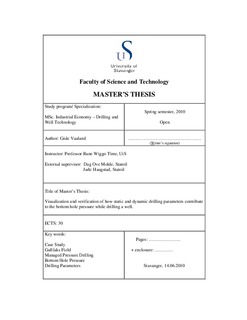| dc.contributor.author | Vaaland, Gisle | |
| dc.date.accessioned | 2010-10-04T09:23:25Z | |
| dc.date.available | 2010-10-04T09:23:25Z | |
| dc.date.issued | 2010 | |
| dc.identifier.uri | http://hdl.handle.net/11250/181963 | |
| dc.description | Master's thesis in Industrial economics | en_US |
| dc.description.abstract | Even with all the talk about finding an alternative fuel, the demand for fossil fuel will not decrease for
years to come. As the major oilfields are depleting and aging, this demand forces wells to be drilled
in more hostile environment both with regards to location, where wells have to be drilled at deeper
water depths, and the environment experienced in the reservoirs that allow for lesser margin of
error. Such advanced and difficult wells are forcing the use of more advanced technology, as
automated drilling and Managed Pressure Drilling (MPD). Common to both technologies are the use
of hydraulic models or down hole pressure estimators to calculate down hole conditions, such as
pressure, temperature, fluid density, etc. The calculations performed by these models does not
always mirror the down hole measurements, and as a compensating factor, the hydraulic models is
adjusted by a not fully understood factor to correlate the model to “reality”. This factor is not always
related to a specific source. The aim of this thesis is therefore to find a way of splitting the
adjustment factor into a stand alone factor for each of the contributing frictional terms, thereby
provide more accurate input data for the hydraulic model that might reduce the need for such a
factor.
Real time data from a well drilled in MPD mode on the Gullfaks field in 2009 was used for
determining how much each of the drilling parameters contributed to the bottom hole pressure
change experienced during start-up and break-up procedures. As the absolute pressure change most
likely will be dependent on depth, the contributions to the bottom hole pressure change caused by
the different drilling parameters was found as percentage of the total bottom hole pressure change
for each run. This provided a basis for finding a mean value with a corresponding standard deviation
of how much each of the drilling parameters contributed to the pressure build-up and decrease for
the start-up and break-up cases respectively.
After these mean values were established, simulations performed in the simulating software
Drillbench © was used to help verify which surrounding factors that could govern the distribution of
how much each drilling parameter contributed to the bottom hole pressure change.
It was found that it was the magnitude of flow rate and RPM that most likely were the governing
factors, and that the depth and whether there was cuttings present or not did not seem to affect the
distribution of which drilling parameters that contributed the most. | en_US |
| dc.language.iso | eng | en_US |
| dc.publisher | University of Stavanger, Norway | en_US |
| dc.relation.ispartofseries | Masteroppgave/UIS-TN-IØRP/2010; | |
| dc.subject | industriell økonomi | en_US |
| dc.subject | case study | en_US |
| dc.subject | Gullfaks | en_US |
| dc.subject | managed pressure drilling | en_US |
| dc.subject | bottom hole pressure | en_US |
| dc.subject | drilling parameters | en_US |
| dc.title | Visualization and verification of how static and dynamic drilling parameters contribute to the bottom hole pressure while drilling a well | en_US |
| dc.type | Master thesis | en_US |
| dc.subject.nsi | VDP::Social science: 200::Economics: 210 | en_US |
| dc.source.pagenumber | 137 p. | en_US |
